Andrew Marshall Wayment's Blog
September 14, 2025
DAMNATION
“I have hunted grouse in all sorts of place and under all sorts of conditions, and I boldly assert that the greatest handicap a grouse hunter is ever called upon to face is a mental one.”
Burton Spiller-“Red-Letter Day”
For me, shooting is such a hit and miss proposition–no pun intended. I’ve written about days when you suddenly receive that “perfect feeling” and it seems you can’t miss. And then there are days when you struggle, but pull it out at the last moment, a little redemption, if you will. And then there are days when you can’t shoot your way out of crap-filled paper bag. Yesterday, I had one of those days.
I left work early on Friday to go grouse hunting with Rainey, my friend John, and his GSP Una. We decided to hunt the creeks, which I dubbed “Easy Pickin’s’” and Butt Kickin’s.” For this hunt, I usually do a loop by starting up the creek bottom that is Butt Kickin’s and then cut east across the mountain side into the creek bottom that is Easy Pickins and hunt down to where that creek enters into the larger creek below. There, at the fence where the private property begins, I head west across the hillside along a two track back to the bottom of Butt Kickin’s. From there, I hike back up to the truck. On good years, there can be grouse anywhere along the circuitous route.
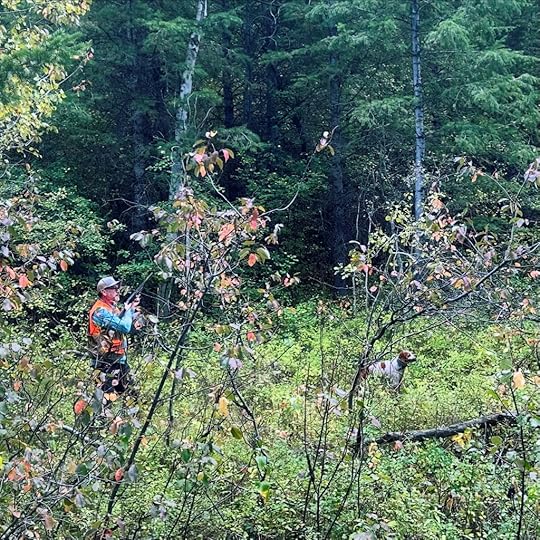 John walks in on Rainey’s point. The bird ended up moving and Rainey tracked it for about 40 to 50 yards. What stellar work on her part!
John walks in on Rainey’s point. The bird ended up moving and Rainey tracked it for about 40 to 50 yards. What stellar work on her part!About a quarter mile from the truck in Butt Kickin’s, Rainey started tracking scent and she worked the bird for about fifty yards and then she finally pointed at the beginning of a couple-of-acre quakie thicket. Una came in from the right and pointed right next to Rainey. What a picture-perfect view! When the bird flushed, I thought I was ready, but it juked when I least expected it and I shot behind it twice. I did not feel bad about that miss even a little because the bird burned me fair and square.
About seventy five yards up the valley, there is an area where bottom narrows between two hills which is choked with quakies and chest high berry brushes that just screams of grouse. The way it is tucked in between the hills makes me think of a subway station because of the plethora of grouse we usually find there. So, I call it the “Subway.” GSP Una circled a service berry bush in the Subway and a grouse cut right in front of me, presenting an easy shot which I missed twice because I did not get my cheek down on the gun. To pour salt into the wound, the bird lit in a tall Douglas Fir right beside me. Ugghhh!!! I groaned realizing I just missed an easy opportunity. Amateur Hour!
With the bird sitting on a limb, I picked up a tree limb and tossed it up there to make the bird flush for another shot. Upon the first throw, the bird simply flew to a higher branch in the same Douglas Fir. I searched for another limb and pitched that one with a vengeance. Instead of flying away from me, the bird then roared over my head at Mach 1. I spun around while raising the RRL 28, squeezed the trigger, missed the fleeting grouse on the first shot, and then dialed in and dropped the grouse on the second. It took us a long time to locate the downed grouse. I’d rather shoot a grouse that flushed from the ground over a tree flushed bird any day. But I pocketed this bird as a consolation prize. We found no more birds in the Creeks and John had to leave early for Una’s training session with a professional trainer.
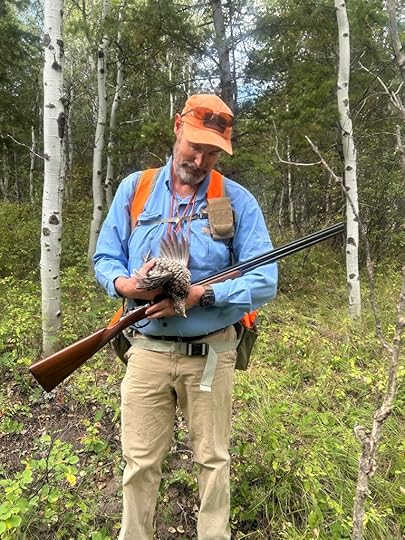 Andy with the consolation prize, a young ruff flushed from a Douglas Fir. It only took me four shots to finally bring it down.
Andy with the consolation prize, a young ruff flushed from a Douglas Fir. It only took me four shots to finally bring it down. So, I drove over to the hill into another creek bottom with numerous familiar coverts along smaller tributaries of the main creek, which include the Quick Draw, Thunder Dome, and Sweet Redemption. I started with the Quick Draw, a narrow side draw off the creek line with berry bushes and quakies that has numerous springs in the tight bottom At times, this little draw can can be loaded with grouse. Rainey and I hiked all the way to the top and moved no grouse. Finally, as we made our way back down to the truck, Rainey struck a nice point on the sidehill in some dark timber. I circled around her and saw a nice, mature gray-phased grouse that was now pinched between us facing Rainey. I stepped forward, but Rainey also advanced. The grouse felt the squeeze and instead of flushing away from me as I expected, it blasted right past me. I promptly missed that bird twice. I honestly had to tip my hat to the wily bird as it truly burned my biscuits. There’s no shame on a miss like that.
Once in the truck, we headed back up the road from whence we came and stopped at the Thunder Dome, which is a covert aligned by a small stream with beaver ponds strung along its length like pearls on a necklace. Because of the beaver activity, and the resulting habitat they create, this covert can also be loaded with grouse at times, but not on this day. Rather, we were chased off by a big black thunderhead that grumbled repeatedly at our presence. The covert was definitely living up to its name.
 I call this covert the “Thunder Dome” after the thunderous flush of ruffed grouse, but on this particular day, the forthcoming ominous storm cloud brought new meaning to the name.
I call this covert the “Thunder Dome” after the thunderous flush of ruffed grouse, but on this particular day, the forthcoming ominous storm cloud brought new meaning to the name. When we made it back to the truck, I checked the time as I needed to be home around 5:30 to get ready for a friend’s wedding. It was 4:00 p.m. and I decided I had just enough time to try one last covert, one I call “Sweet Redemption” because that is where you go when you need to redeem yourself from shooting slumps.
As we worked up the creek bottom, Rainey came into this chokecherry thicket and froze. With the low-lying branches, I could not maneuver directly to her, so I swung around hoping to pin the bird between us. As I moved in, however, Rainey moved off point. Multiple times, she cat-crawled to another point and I tried the same maneuver, but we could not get the moving bird to sit still. Rainey crept up to the last Cedar cluster in the bottom before the little valley opened into a sage flat. I kid you not when I say this, but this was some of the best bird work I have ever seen Rainey do in all of her 8 years. She tracked this bird about a hundred yards through thick cover. Oh, how I wanted to reward her for it! The elusive grouse realized the jig was up and as I swung around, to cut off its retreat, it flushed right toward the cedar thicket. I raised the gun, slid off the safety, sighted the bird, and tugged the trigger.
Click! What the . . . ?
I opened the gun and realized I had forgot to reload. D’OAH!!! I groaned at the perfect lost opportunity due to my own stupidity. I quickly reloaded as Rainey ran into the same cedar grove. Not surprisingly, the grouse blasted out of the cedars towards the thick quakies to my left and I snapped off both barrels to no effect. Obviously, there would be no sweet redemption for me in this cover this day. I looked at my watch and it now read 4:24 p.m. I should have been leaving for home before then. But, oh how the failures of the afternoon still stung!
Instead of taking my lumps and calling it good, I walked right past the truck and crossed the dirt road to the creek bottom below. With Rainey’s excellent dog work all day, I just had to try for one last shot of redemption. I had hunted this area before and found a few grouse. With the thick willow-lined creek and the surrounding quakies, it just screamed of grouse. As if on cue, Rainey started getting birdy near the biggest willow cluster straddling the creek. Instead of going into the willows, however, she veered into the more open quakies to the left. I could not ask for a better set up. Again, she did the cat-like crawl to try to pin down the bird. Again, I swung around to get into position for the shot. As I did, I saw the bird on the ground for a split second and then it flushed hard through the timber. I raised the gun to my cheek, found the proper sight picture, and–feeling that I was dialed in–tugged the trigger. But I did not see the bird go down. Rainey pursued and we both combed through the woods, but did not find any downed bird.
“I can’t believe that I missed that grouse!” I complained, “I know I was on it. This is just not my day!”
The storm cloud from earlier finally caught up to us as we walked back to the truck. I realized that–due to Rainey’s stellar work and the extreme challenge the grouse presented– this was one of the funnest days of grouse hunting that I’ve had in a long time, despite my ineptitude with the shotgun. I thought about the name of the covert across the road–“Sweet Redemption”–and chuckled because I found none today. Given that fact, I decided that this last covert needed its own name, but what to call it? Based upon the persistence of a shooting slump and the perfect missed opportunity, I decided to name the bottom: “I’ll Be Damned!” I laughed out loud as I realized this is the perfect name for the experience. I made it back to the truck at 4:45 pm as the rain started to pour down and I knew I would be late getting home and to the wedding reception.
Sometimes the days where we miss because of the craftiness of the grouse and because of our own follies are the ones that we remember most. While they sting at the time, they can bring smiles to your face for years to come. I can’t wait to go back and try again.
July 4, 2025
LIFE’S EXTRAS ON DAISY LANE
A friend on Facebook recently reached out to me and offered to trade a hunt in Idaho for a bamboo fly rod. Who in their right mind would turn that offer down? I probably would have taken Matt bird hunting without the bamboo rod, but my momma didn’t raise no dummy, so I gratefully accepted the offer.
 The three-piece bamboo rod is a thing of beauty.
The three-piece bamboo rod is a thing of beauty. The beautiful three piece rod came that same week and I was amazed at the craftsmanship and beauty. There’s just something special about split cane rods. And what better fish to try them on than the Yellowstone Cutthroat of my beloved Trickle Creek? This, my friends, is a match made in heaven, but more on that later.
The bamboo rod alone was more than enough, but, after reading my fly fishing book, Heaven on Earth: Stories of Fly Fishing, Fun & Faith, my new friend Matt also sent me a little book entitled: Life’s Extras by none other than the Poet Laureate of South Carolina, Archibald Rutledge, who I have been reading a lot of recently after learning that Rutledge was also a grouse hunter. I was unfamiliar with the book that Matt sent, but his note in the front page intrigued me:
 Life’s Extra, by Archibald Rutledge.
Life’s Extra, by Archibald Rutledge.Andrew,
Your fly fishing & faith book inspired me to send this book your way. The author, for whom my Setter is named, was our State’s first Poet Laureate.
I am a Doubting Thomas, and the first story in this book gives me the evidence I need to believe in God and His love for us.
Best Regards,
Matt
The next morning, I picked up Life’s Extras and read the first chapter as my daily devotional. The book did not disappoint. In the first chapter, Rutledge tells of a wise man riding on the same train as Rutledge who, after observing numerous cattle and a pasture full of daisies, proclaimed:
Look at those little daisies . . . .Many people think them useless, beneath their notice. Materially they are, but spiritually they are priceless; for they manifest a Power that understands the hunger of our souls for beauty, for ‘the city not made with hands.” And that Power generously and sensitively supplies it. Somehow, . . . mere cattle and the solid abundance of money and food that they represent cannot greatly thrill me. There is more hope for humanity in a wild flower than in tons of beef.
Rutledge then pointed out that wild flowers were what he coined as “life’s extras” and he stated:
The more I thought about this, the more it appeared to me that Creation supplies us with only two kinds of things: necessities and extras. Sunlight, air, water, food, shelter–-these are among the bare necessities. With them we can exist. But moonlight and starlight are distinctly extras; so are music, the perfumes, flowers.
After sharing some powerful examples of life’s extras, Rutledge concluded: “At any rate, I know that a thoughtful consideration of life’s extras has done more to give my faith in God actual conviction than all the sermons I ever heard. . . . I am absolutely unshaken in my faith that God created us, loves us, and wants us not only to be good but to be happy.” I could definitely relate to this moving sentiment. I ended up reading the whole book in one day.
On Thursday, July 3, 2025, I snuck away from work at noon and decided to take my new bamboo rod up to my favorite cutthroat stream. Upon reaching my destination, I put together and strung up the bamboo rod and tied on a Renegade. After climbing the barbed-wire fence, I stepped into the stream and immediately saw many cutthroat in a shallow riffle. I cast the fly to the fish, one took, but I was slow and missed on the strike. The fish spooked.
 Bamboo and Trickle Creek belong together.
Bamboo and Trickle Creek belong together.Usually, I am a run-and-gun kind of fly fisher, moving quickly up a stretch of creek. However, holding that beautiful, handmade bamboo rod made me want to slow down and savor the experience. The wild daisies along the creek were in full bloom and their beauty was not lost on me. Reflecting on the moment and the past, I realized that my favorite times on the creek were when the wild daisies are in full bloom.
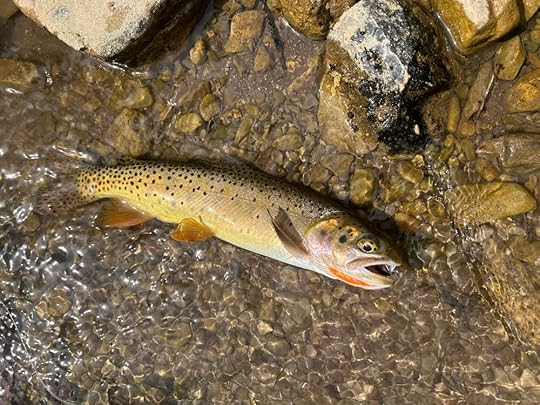 Gorgeous Yellowstone Cutthroat
Gorgeous Yellowstone CutthroatAs I stepped up to the next run, I cast the Renegade and an eager cutthroat rose and slurped it in. I quickly brought that gem to hand and admired briefly its beauty. I slowly worked my way up through the creek and caught numerous fish in every run and hole. In tight areas that I usually pass by with my tenkara rod, I successfully fished with the bamboo rod using the bow and arrow cast. The fish came easily to hand that afternoon.
Slowing down my pace also made me reflect on Rutledge’s wise words. I acknowledged then that the bamboo rod from a friend, the cool, clear creak, the plentitude of all of wild daisies lining its banks, the gorgeous cutthroat with crimson gills and hunter orange slashes, are all of life’s extras that brought a big smile to my face.
 The fish of the day.
The fish of the day. If that were not enough, the abundance of daisies made me think of the chorus to a song by a favorite band, Switchfoot, entitled “Daisy”:
Let it go
Daisy, let it go
Open up your fists
This fallen world
Doesn’t hold your interest
It doesn’t hold your soul
Daisy, let it go
Those words complimented the whole experience at the moment so succinctly that I was moved to tears by the sum of it all. I would describe the moment as spiritual. It was as if the voice of God sent me a little message. Like Rutledge, I could not help but conclude that these joyous life’s extras were not a coincidence. Rather, they are a testament to a loving Creator who knows me intimately, loves me, and wants me to be happy. I drove home that night feeling immensely grateful.
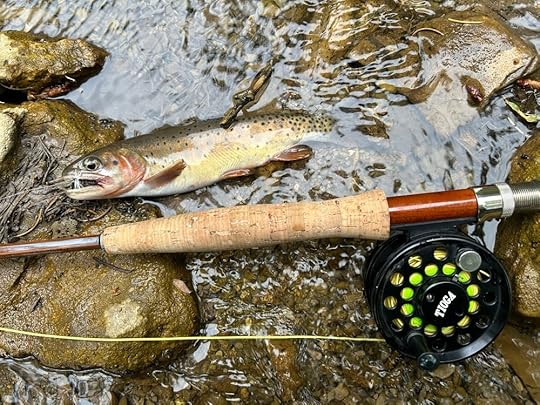
In honor of this sacred experience, this stretch of Trickle Creek will from now on be called “Daisy Lane.”
 Daisy Lane is a little stretch of Heaven on Earth.
Daisy Lane is a little stretch of Heaven on Earth.
August 4, 2024
ETCHED IN THE LANDSCAPE
Yesterday, my friend, John Anderson, and I went out to a favorite covert, Grouse Springs, to run our dogs before the start of our hunting season, which is only a few weeks away. After years of tagging along with Rainey and I grouse hunting, John finally has own birddog, a German Shorthair named “Una.” Before the summer sun chased us off, we found a total of 13 ruffed grouse and 2 blue grouse, which suggests the upcoming hunting season should be good.
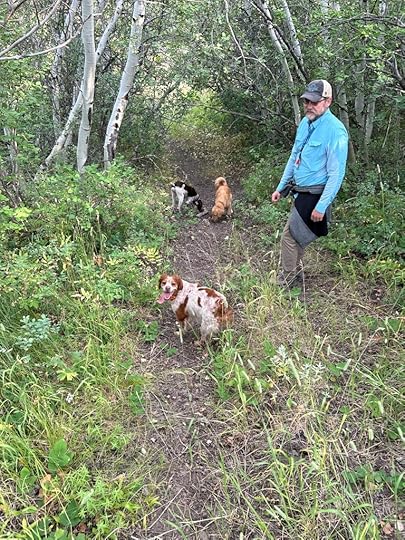 John and the dogs descend into Grouse Alley, a particularly productive ruffed grouse covert.
John and the dogs descend into Grouse Alley, a particularly productive ruffed grouse covert. The year 2024 will mark 20 years of hunting this covert with my bird dogs. Sunny Girl, Dusty, Misty, Brandy, and now, Rainey, and Aki all cut their teeth on grouse in these woods. After twenty years, every time I traverse this covert, hundreds of memories of my dogs come flooding back as I remember the triumphs and the mishaps we shared there. For that reason alone, this covert is sacred to me. I know almost every inch of this ground intimately. To say that my coverts are of great importance to me is an understatement. They are an essential part of who I am, my past, and my future.
 Rainey and Aki are the latest duo of dogs that have traversed this covert with me over the years. We have so much fun together.
Rainey and Aki are the latest duo of dogs that have traversed this covert with me over the years. We have so much fun together.
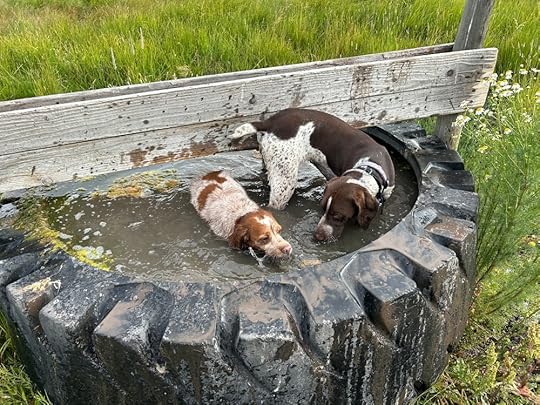 The main spring has been piped into this guzzler and the dogs often use it to cool off.
The main spring has been piped into this guzzler and the dogs often use it to cool off. During our hike in Grouse Springs yesterday, I came upon something I do not remember. In the big grove of old quakies to the right of the springs, I found carved in a tree, clear as could be: “AW + KW.” Seeing that stopped me in my tracks. At first, I questioned: Who did this? I like to think my momma didn’t raise no dummy and I quickly deduced that yours truly is the culprit because that is mine and my wife’s initials. I must have written that many, many years ago when I was hunting up in Grouse Springs by myself, but I don’t recall carving that into the tree. Over the years, I have passed that spot dozens of times, but I must have overlooked it and the memory escaped me. Growing old will do that to you.
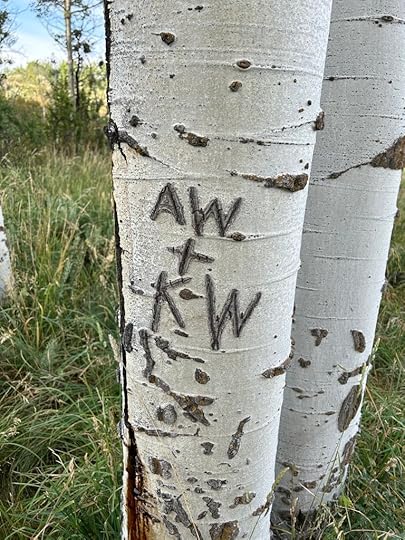 Etched in bark for all the world to see.
Etched in bark for all the world to see. Of course, my mind reeled wondering when specifically did I do this?. Was it during those first years when I experienced a blizzard on my wife’s birthday in September and wondered whether I would make it home in time to make her a cake? Maybe this was my penance for going hunting when I should have been spending time with her. Maybe it was after that time Sunny Girl pointed a grouse nearby that ran along the downed tree in front of her and I made the shot. That is certainly a cherished memory. For the life of me, I could not remember.
The engraving instantly reminded me of a painting owned by my dad with a rocky mountain peak in the background and a quaking aspen in the forefront carved with “KW + CW,” which are the initials of my parents. My dad was a doctor and often treated patients who could not afford to pay for his services. A patient offered to paint this for him in trade and my generous dad accepted. I loved that painting even more after I learned the story. My dad passed away over ten years ago and I miss him dearly, but think of him often in my outdoor outings as he instilled that love in me from an early age. In my reflections, I considered that maybe I carved mine and Kristin’s initials in that tree with my Dad and that painting in mind sometime after he died. That made sense, but again, I just cannot remember the particulars.
One of my favorite things to do in the outdoors is to go and see Native American Petroglyphs and Pictographs. Though the creators have long since passed on, you can still know of their passing and feel of their presence in some way. Those areas feel sacred to me. In my studies of Native American culture and history, I have also learned that many of the eastern tribes used birch bark to preserve their sacred memories. Quaking Aspens, or “quakies” as we call them out west, with their white bark, are closely related to birch trees and people often make their mark on these trees that show for years to come. This begs the question of what is worthy to preserve in that way?
As a Life Scout, I typically espouse the practice of “Leave no Trace” when I am outdoors, so the fact that I carved this sometime in the past surprised me. However, as I have reflected on this, the thought came that maybe truly leaving no trace is really not possible. Just as our coverts become an important part of who we are, maybe we shape our coverts in some ways (hopefully in a positive way).
Regardless of how and when this happened, I’ve come to the conclusion that it is truly fitting. Now, in a small way, my wife and I are etched on the landscape that I have loved so dearly. I can think of no better message I could leave for others. Now other passersby (hopefully my kids, for that matter) might see it and know that I was there and I wanted to say something that would last and truly mattered. Like I mentioned, this covert has always been sacred to me because of the memories of all my bird dogs, but it is even more so now.
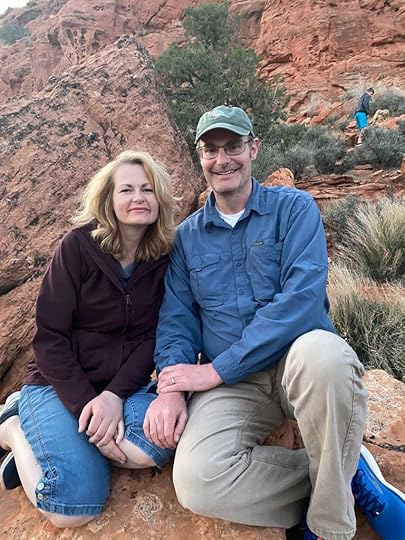 Kristin is my best adventure buddy, she has put up with all my outdoor shenanigans now for almost 30 years. If I could only write one thing that would be preserved, I wrote it all those years ago on a quakie in the grouse woods.
Kristin is my best adventure buddy, she has put up with all my outdoor shenanigans now for almost 30 years. If I could only write one thing that would be preserved, I wrote it all those years ago on a quakie in the grouse woods.
November 23, 2022
A PERFECT HUNT IN A DIFFICULT YEAR: A Thanksgiving Story
COVID-19 was hard on everyone. When the lockdown came in Idaho in March of 2020, winter still maintained its chilling grip on the landscape, and even though the seasons all came that year, the isolation from other people and the fear you saw in their eyes made it seem like Ol’ Man Winter never really left.
At least one could find some solace in the outdoors during this difficult time. I took to the outdoors more than usual that year fishing and hunting whenever I could. Fortunately, the grouse population stayed strong and all my coverts held plenty of birds throughout the hunting season. I relished every second of my time in the grouse woods that fall.
For Thanksgiving, my extended family decided to meet up for dinner. This would be the first time we had joined together since the onset of the pandemic. Because I would be away from my home coverts, I planned to get away to a beloved covert named “Grouse Rock,” not far from my mom’s hometown, for a Thanksgiving morning hunt.
To my surprise, we awoke that morning to a snowstorm, which laid down a light dusting in the valley. From experience, I knew the mountains surrounding us would likely have much more snow than at home. Even in November, winter can rear its ugly head and shut things down quickly. Of course, I questioned: Should we risk it? What if we get stuck?
I conferred with my oldest son, Tommy, whether he still wanted to come hunting with me. He declined carrying a gun, but agreed to tag along for a quick hunt. I promised we would keep it short due to the weather and the forthcoming holiday feast and festivities.
We loaded up our dog Rainey into the Expedition and made our way southeast to the mountains. There was a break in the clouds as we approached the canyon letting a little sunlight through. The further up the dirt road we drove, however, the skies became gloomier and the snow deeper. Once we rounded the bend past the reservoir into the narrow mountainous valley leading to my covert, the snow fell in earnest piling its powdery substance up to our front bumper. The car’s momentum caused the snow to fly over the car making visibility difficult.
“This is sketchy Tom, should we turn back?” I asked concernedly.
“I don’t know, Dad.” Tom replied.
“We are so close, and even though the snow is deep, we are not slipping around. Besides, I don’t even know where I would turn around. Let’s just keep going until we get there and then get turned around and go for a short hunt.” I resolved.
“Okay Dad,” agreed Tom.
When we got to Grouse Rock—a prominent rocky outcrop on the righthand side of the road—I heaved a sigh of relief as we plowed our way off the road to where I typically park. I backed the car in and out of this spot a few times just to make sure we could make our escape when the time came. So far, so good.
 The snowy grouse woods are majestical.
The snowy grouse woods are majestical. With the huge snow flakes steadily falling, the desperate hunt seemed more like some stubborn act of rebellion: A firm statement to winter that I would decide when the grouse hunting season was over. To quote Dylan Thomas, this was my own “Rage, rage against the dying of the light” that winter always brings. Tom and I bundled up, released Rainey from her kennel, put a bell on her collar, and pushed towards the timbered draw.
With the deep snow, the going was tough as each step required more energy than a typical saunter in the woods. Rainey didn’t seem to mind as she barreled joyously through the powder. As we reached the timber, the snow’s accumulation lessened some, which made things a bit easier. Still, I wasn’t sure how far we could make it up into the covert as it steepened, and the trees—both standing and deadfall—thickened.
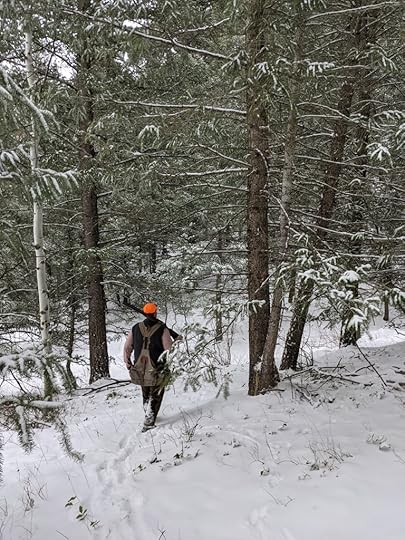 The dark timber helps to keep the snow accumulation down some and grouse will use it for cover and roosting.
The dark timber helps to keep the snow accumulation down some and grouse will use it for cover and roosting. Despite the muffle caused by the deep snow, the chime of Rainey’s bell still cut through the woods. We tried to keep up as she traversed through the forest. As Tom and I approached near where the covert transitions from Quaking Aspens to Douglas Firs, I suddenly noticed the absence of the bell. I scanned the woods to where I last heard it. Through the whiteout, I finally saw Rainey on point beneath a large pine tree.
“Tommy, Rainey is on point. Let’s get over there!” I said as we both made our way towards her.
 Behold a grouse dog extraordinaire! Rainey sticks a grouse beneath a big Douglas Fir.
Behold a grouse dog extraordinaire! Rainey sticks a grouse beneath a big Douglas Fir. As we drew closer, a solitary ruffed grouse hammered right to left across the opening, trying to make it to thicker cover. With only a split second to shoot, I swung the Ruger Red Label 12 through the grouse and tugged the trigger as it disappeared behind the forest canopy and the shot rang loudly through the wintery woods. I honestly had no idea if I made the shot or not.
Upon the flush, Rainey followed the bird’s trajectory and—though her retrieving left something to be desired at the time—she disappeared into the woods and then reappeared with a beautiful, limp ruffed grouse in her mouth.
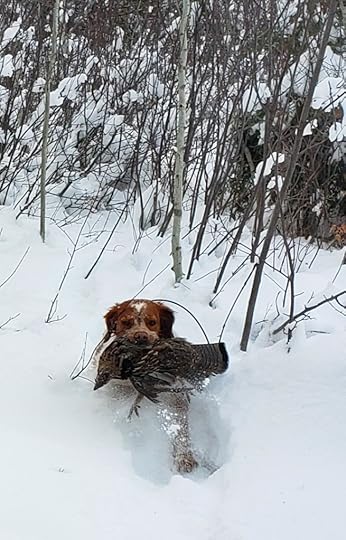 Rainey has become quite the retriever since this hunt.
Rainey has become quite the retriever since this hunt. “Did you see that Tommy?” I asked incredulously. “I can’t believe I just made that shot!”
“I sure did. Good shot, Dad!” Tommy praised.
Rainey dropped the bird beneath a nearby pine tree and I quickly made my way over, picked it up, and admired its beauty through the falling snow.
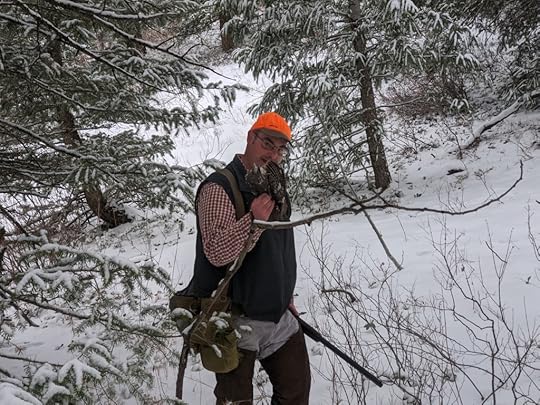 I could hardly believe I made that shot.
I could hardly believe I made that shot. “Tom, I’m not sure we can top that: One point, one shot, and one almost nice retrieve. That’s a perfect hunt in my book. It can’t get any better than that! Should we get out of here?” I asked.
“Yes, let’s get while the getting’s good.” Tom suggested.
We trudged our way through the accumulating snow back to the Expedition and, to our relief, we were able to pull back onto the road without a hitch and make our way safely back home in time for a Thanksgiving feast. My little rebellion had paid off and I felt grateful. Ol’ Man Winter could now firmly reclaim his own. Looking back, I can honestly say that my time in the great outdoors that difficult year made life more livable.
This year, when you count your blessings on Thanksgiving, be sure and express thanks for the limited days we get to spend with our bird dogs in beautiful places. As I always say: Every day in the grouse woods is a gift. Savor every second!
Happy Thanksgiving to everyone from the Wayment Brothers!
November 13, 2022
THE IMPORTANCE OF MENTORING
“There is nothing good unless you do it.” -Eric Kastner
By all accounts, the sport of hunting is dying. Every year, our nation is facing a decline in the numbers of hunters as gauged by the number of hunting licenses sold. Part of the problem is the absence of mentors for those interested in hunting. Let’s face it: Learning how to successfully chase birds with bird dogs takes patience and time. It took me years to figure things out and I still have a lot to learn. Admittedly, I have not been the best at reaching out to newcomers and welcoming them along for a hunt, but I am trying to do better.
Every year, Shawn and I get together for a week of hunting in the Idaho uplands and we both post voluminous photos of these outings on social media, hopefully to everyone’s delight (or annoyance as the case may be). In October of 2016, towards the end of our week, a friend on social media, Sam Smedley, messaged me that he loved seeing all my photos, had just started bird hunting, did not yet have a bird dog, and would love to come and spend a day with me in the uplands. Feeling generous, I invited him to come and hunt with me, my brother Shawn and my son Tommy on a new property that I had just received permission for that year. We met at Smitty’s in Idaho Falls on a Saturday morning for breakfast, then headed out to our hunting destination.
During breakfast, I found Sam to be an easygoing, likeable young man. He told us he was going to school and was not yet married. I explained to him that we would be hunting a property owned by a client that reportedly held sharptails. He responded that he had only taken one sharptail during his short hunting career and was eager to experience more of them. His enthusiasm for the hunt was infectious. I bought his breakfast and we traveled northeast to our hunting destination.
The late October morning was chilly, but the skies were mostly clear. The new covert looked appealing with rolling, grassy hills and thick pockets of quakies tucked on the hillsides, where the plow couldn’t reach and annual moisture remained longer. We first hunted up the edge of the property and flushed numerous birds up top. The landowner had informed me that the property was enrolled in the Idaho Fish and Game’s SAFE program which is a habitat program for sharptails where the landowner plants food and cover. The program worked on this property as there was no shortage of birds, even though the surrounding properties were devoid of cover because of the prevalent wheat production.
 Shawn and Sam Smedley shoot breeze before the hunt.
Shawn and Sam Smedley shoot breeze before the hunt. In the far, southeast corner of the property, Misty pointed a bird and I made a nice shot which Misty retrieved to hand. We then swung back to the crest of the tallest hill in the middle of the property, covered in sagebrush and straddled by quakie patches on the steep hillsides. Some of the birds that we flushed earlier had flown up to the top of this hill and we pursued. At the narrowest part between two quakie patches, Misty became birdy and began to cat crawl. Sam and I pursued, and when the sharpie finally flushed, he made a great shot, dropping the bird over the edge into the trees. Misty showed off with a nice retrieve and Sam smiled wide as he soaked in the experience.
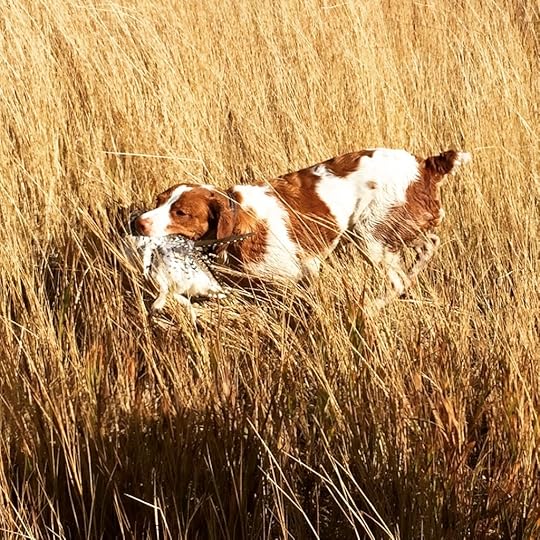 Misty makes a nice retrieve of Sam’s second sharptail ever.
Misty makes a nice retrieve of Sam’s second sharptail ever.
 I honestly enjoyed watching Sam get this grouse as much as if I had done it myself.
I honestly enjoyed watching Sam get this grouse as much as if I had done it myself. We crossed over the road to another area we had permission to hunt and were amazed at the volume of birds. Misty worked them perfectly, but unfortunately, they flushed out of range. On the far side of the property, we found this weedy area that wasn’t much to look at, but the sharptails begged to differ. We flushed a mega covey of sharptails and Shawn made an incredible shot as one flew high over his head. With that, all three of the gunners had bagged a bird from the new covert. The panorama from the property of the snowy Big Hole Mountains to the north was breathtaking. As we walked back to the truck, I named the covert, “Summer’s End” because I knew that winter was not far off. You could feel it in the cool, fall air.
After our sharptail hunt, we celebrated at the truck with a few cold rootbeers provided by Shawn. We then hunted a nearby ruffed grouse covert, Butt Kickins’, but saw no birds. Still, we all felt the hunt was a success. Sam took his leave from us from there.
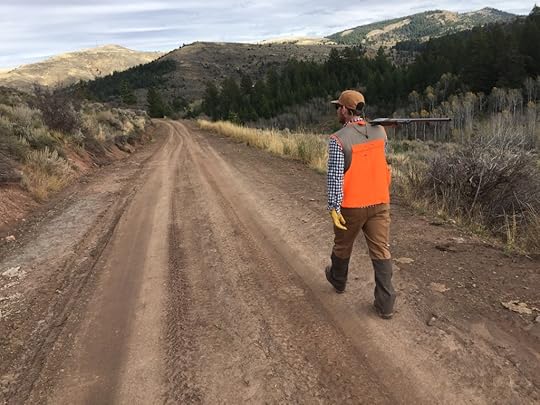 Finishing up the hunt. It was a pleasure to hunt with Sam.
Finishing up the hunt. It was a pleasure to hunt with Sam. Since that time, much has changed. Misty passed away in March of 2017 and Rainey, my French Brittany, came to my home in June of 2017. Though we have not hunted together since, I have kept tabs on Sam through social media. I was excited to see that he eventually got a bird dog of his own, a liver and white Brittany named, Scottie, in March of 2019. I always wondered if his choice of breed was because of the show that Misty put on that October day.
I also saw that he married a girl from New York City in 2021 and moved there to start his family. As a lover of the outdoors, I wondered how this leap of faith would work out for him and Scottie.
On September 25, 2022, I unexpectedly received a message that warmed my heart:
Hey just wanted to reach out and say that you taking me out hunting that one time has changed my life. As you know I got my Brittany. I moved to NYC and just got my first Adirondack ruffie.
I was thrilled to get this message and see pictures of Sam’s eastern ruffed grouse and to tease him about trying to keep a bird dog in NYC (“Get a rope!”). More power to him!
This story goes to show you that one seemingly insignificant hunt shared with a newcomer can make a huge difference in their life. Those of us who are addicted to the pursuit of upland birds can’t keep all this excitement and beauty to ourselves. We have to pass it on to the next generation to ensure the future of our wonderful sport.
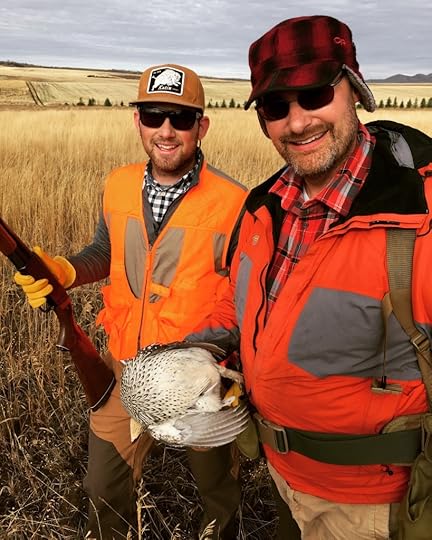 In the words of the Roman Statesmen, Marcus Aurellius: “The only wealth which you keep forever is the wealth you have given away.” Nowhere is that more true than in upland wingshooting. Take the time to mentor someone in our great sport.
In the words of the Roman Statesmen, Marcus Aurellius: “The only wealth which you keep forever is the wealth you have given away.” Nowhere is that more true than in upland wingshooting. Take the time to mentor someone in our great sport.
May 7, 2022
PREORDER SIGNED HARDBACK COPIES OF IDAHO UPLAND DAYS
A few days ago, I did a post about preordering paperback copies of my new book, Idaho Uplands Days: Reflections on Bird Dogs, Banner Days, and Other Roadside Revelations. I wrote the following for the back cover blurb:
With nine species of upland game birds, Idaho is truly a cornucopia for the upland bird hunter and his or her canine companions. If you are looking for a where-to/how-to book, this is not the book for you. Rather, this is a collection of stories from the author’s life about bird dogs, beloved hunting companions, banner days afield, and other Roadside Revelations along the way. Come join Andrew Marshall Wayment as he shares the adventure, the excitement, and the beauty of Idaho Upland Days.
So far, the response has been good and I appreciate the support.
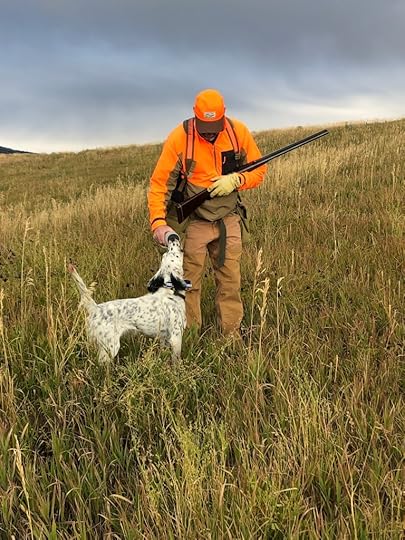 Shawn and Cinder at the Royal Macnab
Shawn and Cinder at the Royal MacnabI am happy to report that I am ready to do the preorder for the hardback editions of the book. Yes, you read that right “editions“! I decided to do a first edition with all color photos and a second edition with only black and white photos. Because of the color photos, there is a difference in pricing for these respective editions. The first edition will retail for $45.95 on Amazon and the second edition will retail for $26.95 on Amazon.
For those interested in preordering signed copies of either of these editions, I am offering the First Edition for $51.00 (which amount includes shipping and handling) and the Second Edition for $32.00 (which amount includes shipping and handling). You can either send the money to my Venmo account @andrewmwayment or, if you prefer to send a check or money order, you can send me an email directly to andrewmwayment@gmail.com to find out where to send it. Please make sure that you tell me the Edition you are ordering and the address to mail the book. If you are concerned about sharing your address with the public, please make your Venmo post private or send me an email with your address. This offer is only for people living in the United States. If any outside the U.S. are interested, please contact me by email to discuss how this can be done.
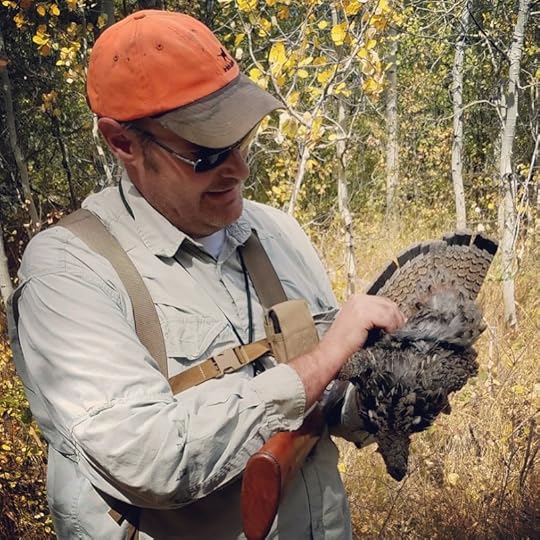 Andy and a nice ruffed grouse.
Andy and a nice ruffed grouse. I am excited to finally share this book with the world. I hope that people will love it!
May 3, 2022
PREORDER A SIGNED PAPERBACK COPY OF IDAHO UPLAND DAYS BY ANDREW MARSHALL WAYMENT
Last year I appeared on The Flush podcast with Travis Frank and he asked me when I was going to publish my next bird-hunting book and I joking said, “Probably in five years.” I am happy to report that my second bird hunting book, Idaho Upland Days: Reflections on Bird Dogs, Banner Days, and other Roadside Revelations, is done and will soon be available for purchase.
I wrote the following as the back cover blurb for the book:
With nine species of upland game birds, Idaho is truly a cornucopia for the upland bird hunter and his or her canine companions. If you are looking for a where-to/how-to book, this is not the book for you. Rather, this is a collection of stories from the author’s life about bird dogs, beloved hunting companions, banner days afield, and other Roadside Revelations along the way. Come join Andrew Marshall Wayment as he shares the adventure, the excitement, and the beauty of Idaho Upland Days.
Though it comes second, this is actually the first upland bird hunting book that I wrote. The majority of the stories took place before those in Idaho Ruffed Grouse Hunting: The Heartbeat of the Woods and before grouse fever got ahold of me. Many of these stories and essays first appeared in the Upland Equations and Upland Ways blogs as well as various upland-related magazines. For those who read, Idaho Ruffed Grouse Hunting, they may recollect that I was originally going to title the book, Roadside Revelations, after an article that was published in The Upland Almanac, but decided to change the name to Idaho Upland Days and include Roadside Revelations in the subtitle. Still, this is the same book.
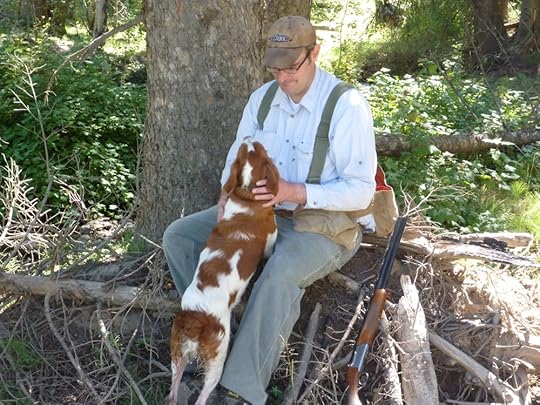 Andy and Misty
Andy and MistyThe book contains thirty-five self-contained chapters on various things relating to bird dogs and upland bird hunting in Idaho. The book has numerous black and white photos throughout to support the stories and make the book more visually appealing. I am also pleased to announce that Ross B. Young gave me permission to use his painting “Columbian Sharptails in the Foothills-Sharptail Hunting in Idaho” as the cover of the book. Another painting of Ross’s, “Sagebrush Huns,” which was inspired by a hunt with my late Brittany, Misty, appears in the Introduction to the book. What an honor it is to work with Ross, a fellow Idahoan, on this project!
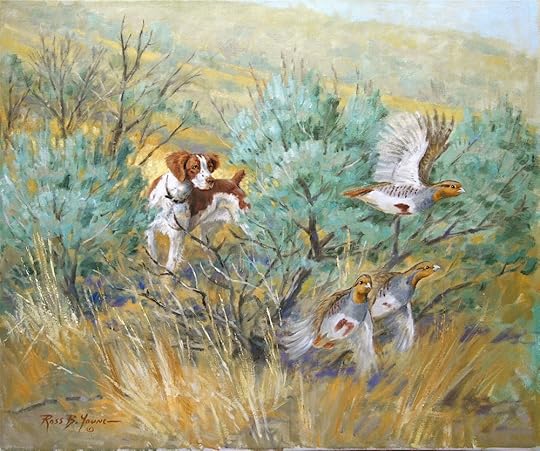 Sagebrush Huns by Ross B. Young.
Sagebrush Huns by Ross B. Young.
At this point, I am just waiting to receive the proof copies from the publisher to review and approve. Once this is done, then the book should be available on amazon.com. The retail price is $19.95.
Idaho Upland Days will also shortly be available in hardback on amazon.com and I am hopeful that all of the photos therein will be in color to set it apart from the paperback. We still have some work to do to make this happen.
The major purpose for this post is to offer the opportunity to preorder signed copies of the paperback. If you are interested, please send to me $26.00 via Venmo to @andrewmwayment. This amount includes the price of the book and the cost of shipping and handling. Please let me know with the Venmo payment the address to mail the book. If you do not do Venmo, please send me an email at andrewmwayment@gmail.com and I will let you know where to send a check. This offer is only for those who live in the United States. If you live outside the United States and want a signed copy, please contact me by email to discuss how to purchase as signed copy from where you live.
If you have your heart set on the hardback, please hold off and I will prepare a similar post regarding how to preorder a signed copy of the hardback. The cost will be more, but don’t know exactly how much yet.
Please help me to spread the word by sharing this on your social media accounts! Thanks in advance for your support!
March 5, 2022
BRET WANNACOTT’S A MILLIONAIRE’S DREAM
It has been a while since I did a book review on the blog. To be honest, I rarely get excited enough about a book to put the effort into writing a review. However, I just read my friend Bret Wannacott’s book, A Millionaire’s Dream, and thoroughly enjoyed it.
I’ve known Bret on social media for over ten years. I’ve always enjoyed reading about him and his setters, their training, hunting adventures and field trials. Bret and I share a love of forest grouse hunting with pointing dogs and I’ve enjoyed seeing photos and videos of his hunts over the years. Bret is also a waterfowl hunter and, believe it or not, he uses his setters to hunt ducks and geese. In addition, he is a former Utah State champion duck caller, passionate chukar hunter and conservationist, and also takes time to teach youngsters about his passions.
When Bret announced a few years back on social media that he was working on a book, I was excited to read about his hunting adventures and immediately reached out to him to find out what he was working on. To my surprise, Bret related that he was not working on a book about his hunting experiences, but rather on a fictional novel. To be honest, I didn’t know what to expect or how his love of bird dogs and upland bird hunting would come into play. I have to admit that at the time, I thought this was an ambitious undertaking and was a bit skeptical. Thank goodness Bret stayed the course and wrote A Millionaire’s Dream.
This book is the story of 17-year old James Crockett, who is suddenly orphaned when his mother passes away from cancer. Other than some relatives and a few neighbors, James is all alone and, as you can guess, he is distraught for a time as he tries to work and hold together the family farm located in 1950’s Idaho. By happenstance (or better yet, divine providence), he runs into a young stray setter that he names “Bud” and the dog brings hope and joy back into his life. James soon finds out that the dog belongs to a wealthy man from Boise, George Knutson, who paid a lot of money for the setter as a field-trialing prospect. Of course, Knutson comes to get his dog back over the pleas of James. At the loss of his new friend, James again plunges into depression. Not wanting to spoil any of the plot for the readers, I will say that big-hearted Knutson later works out a deal with James that is mutually beneficial for the two of them and this turns James’ life around for the better.
The book covers James’ journey of learning about life, love, hunting, and bird dogs. In the process, James finds his community and his family. Fittingly, James’ first hunt with the dog is on forest grouse and it was fun to read about another duffer in the grouse woods. The book also touches upon some of Idaho’s other game birds: pheasants, Huns, sharptails, and chukar. Bret’s writing on these species rings true based upon his extensive experience as a hunter.
The book is well written and the compelling story draws you in. I read it in less than two days and found myself cheering for James and the dogs. I would compare the story, especially the field-trialing sections, to the great writing of Vereen Bell, the author of Brad Dog, who died in World War II. If you don’t know Vereen Bell, do yourself a favor and go read his stuff! Trust me, it’s that good!
Bret took a risk and it paid off. People are taking note as the book has received numerous positive reviews on Amazon.com and elsewhere. I’m so glad he took the time to develop and share his talents in this book. Here is a link to where you can find it https://bretwonnacott.com/.
I understand Bret is writing a second novel and that he is about ten chapters in. If A Millionaire’s Dream is any indication, then we are in for a treat!
February 5, 2022
DUCK CAMP: GREAT PRODUCTS FOR ANGLERS AND HUNTERS
NOTE FROM AUTHOR: This is not a paid endorsement or review and I am not an ambassador for Duck Camp.
I’ve been meaning to write this review for a while, but life (and Covid-19) got in the way. I first heard of Duck Camp a few years back after I published an article in the Project Upland magazine entitled, “Discovering Tinkhamtown.” A Duck Camp representative contacted me and asked me if I would like to try their product and offered me one of their upland-game hunting shirts and, of course, I accepted. I chose the heavy weight tan and hunter orange chamois shirt. Upon receipt, the shirt was super nice and comfortable, but was a little too small for me, so I gave it to brother Shawn as his Christmas present that year.
At the time, I was looking for a good, light-weight rain jacket, and approached Duck Camp about letting me review their 3L Ultralight Rain Jacket in Mallard Green, and they graciously agreed. I first received this jacket in late October of 2019 and wore it the rest of the hunting season and also used it in the 2020 and 2021 hunting Seasons. It worked well as a light jacket on warmer days and also as the outer shell with underlying layers in the late, snowy season.
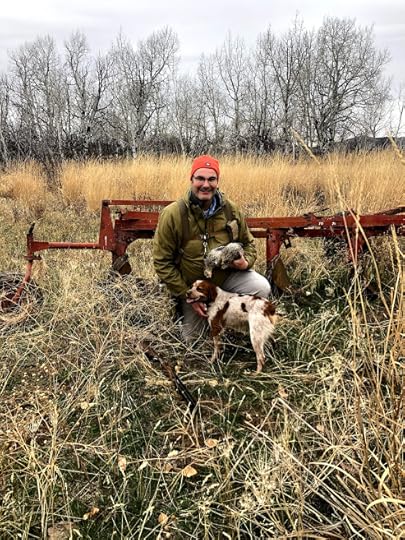 First Hunt with the 3L Ultralight Jacket. Late season sharptails.
First Hunt with the 3L Ultralight Jacket. Late season sharptails. I also used the jacket often for my fishing outings and it treated me right. I even took the jacket with me to Southeast Alaska last summer for salmon fishing and it worked pretty dang well in that humid climate, especially in the rain.
 The jacket works awesome for spring and winter fishing.
The jacket works awesome for spring and winter fishing. Overall, I found the breathable jacket to be pretty durable, but unfortunately, I did tear a hole in the hood when I got horse-collared in a thicket while trying to get to Rainey pointing a ruffed grouse. I patched the jacket up with a black Goretex patch, which looks okay and works to keep me dry.
In short, having used raincoats from Cabelas, Columbia, and Mountain Hardwear in the past, I can say without reserve, that this is the best waterproof jacket I’ve ever personally owned. I love it!
In fact, I loved the jacket so much that I decided to order two of their longsleeve Hooksetter fishing shirts including the Red Drum Plaid and the Bull Trout Plaid. They are both great shirts that I have enjoyed wearing fishing and hunting.
 Andy living up to the name of the shirt, but Alaska makes that easy!
Andy living up to the name of the shirt, but Alaska makes that easy!For those of you who follow the blog, you know I don’t do a ton of reviews, so this is kind of a new area for me. But I can say without reservation that Duck Camp makes a good product and I recommend it to anyone. My only complaint is that they didn’t name their company “Grouse Camp,” but I guess I’ll just have to live with that!
 Think they will change their name to Grouse Camp for me? Thanks Duck Camp for letting me review your great product.
Think they will change their name to Grouse Camp for me? Thanks Duck Camp for letting me review your great product.
January 19, 2022
Sportsman’s Palette: Collecting Sporting Art Tips
Art for art’s sake is simply wonderful. Art in all its forms is beautiful, engaging, and culturally enriching. Plus, humans have quite literally been making art since the beginning of time. It’s an intrinsic part of being human – creativity is part of what defines us. To quote Robin Williams as John Keating, “We don’t read and write poetry because it’s cute. We read and write poetry because we are members of the human race. And the human race is filled with passion. And medicine, law, business, engineering, these are noble pursuits and necessary to sustain life. But poetry, beauty, romance, love, these are what we stay alive for.” (Weir, 1989.)
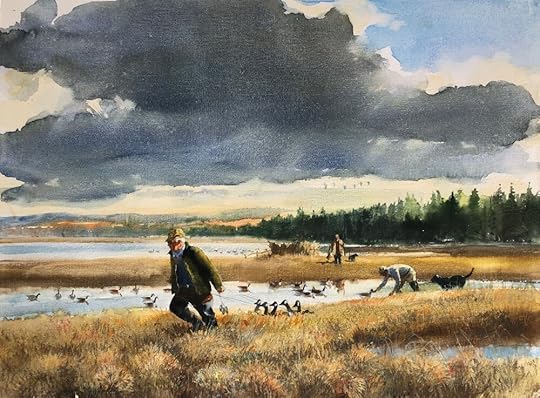 Golden Setting Up
Golden Setting UpThe Sporting World – sporting pastimes being a true art form in and of themselves – has mastered, with aplomb, art for the sake of a story. It has mastered art not just for the sake of art, but for the sake of a moment, a memory, a feeling, a history. Like Arthur Shilstone’s bucolic Upstate New York fields where he spent his depression-era childhood hunting pheasants, or Sebastián Letelier’s majestic Norwegian rivers upon which he landed his first Atlantic salmon, or Claudio D’Angelo’s sublime Canadian wilderness where he spent his childhood filling sketchbooks with the beautiful, secretive world of the wildlife that lives there.
Since the advent of the genre in roughly the 18th century, the world of Sporting Art has mastered and fine-tuned the practice of capturing a precious, often intimate, and certainly fleeting moment and immortalizing it in visual form. And it’s not just any mundane way of documenting the sportsman’s beloved pastime – it’s a true fine art, and takes an artist a lifetime to master. It’s the apex of storytelling through fine art.
In the Sporting World, a work of art contains life far beyond the painting itself. It’s a way of illustrating an important story, in fine art form. The art is visually and aesthetically beautiful, yes, but what is perhaps more beautiful is the sense of place, time, history, and memory that it brings to the collector. It immortalizes the story that you want to tell.
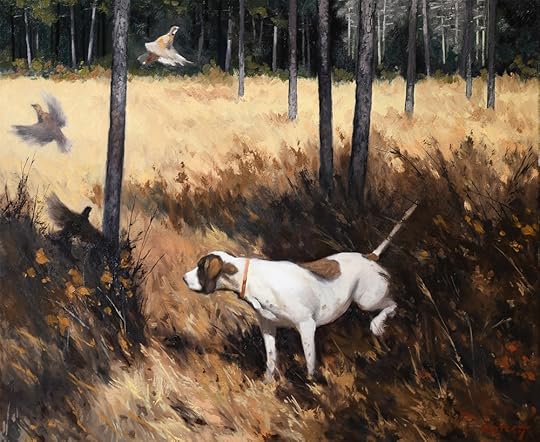 Bartlett A Flush
Bartlett A Flush For all the sportsmen and sportswomen out there who do want to start immortalizing their stories with a collection of art – at first it can seem daunting. The world of art is huge, with an endless supply of options. Even the Sporting Art World, a tiny niche within the greater art world, can seem overwhelming at first. As two professionals within this small niche, one a seasoned veteran with 30+ years of experience and the other with a younger vision and approach to the subject matter, we’ve broken down a few key points of art collecting that may help make it easier to approach the endeavor.
Firstly, start early and look often! You’re never too young to call yourself an art collector – no matter what type of art you collect. Always be on the lookout, and use every opportunity to your advantage. Art can be a wonderful financial investment, but, we believe more importantly, it is without a doubt one of the best emotional investments you can make. When you surround yourself with things you love and within which you find incredible beauty, the sun shines a little brighter.
Concerning the question of what exactly you should be looking for when you want to collect – Do I look for things that will match the visual aesthetic of my space and the things I’ve already collected? Or do I search for pieces with which I have a strong emotional connection, regardless of how well they ‘match’ my space and other pieces? The color scheme of Roger Blum’s ‘The Old Corn Field’ would go really well with the rest of my décor, but I really love ‘The Grouse Hunter’ because it reminds me of my old hunting dog – which one should I buy? In our professional opinions, the answer is: you should do what you want. We can’t, and shouldn’t (nor should anybody else) dictate how you collect. Gallerists and dealers exist to give you professional guidance and area expertise when you want it, but we can’t dictate exactly what you should or shouldn’t buy. We strongly believe that going with your gut will reward you in the long run – if you’d rather have a home and collection that has a cohesive style and color scheme, regardless of subject matter, then do that if it makes you happy. If you’d rather have a collection full of the subject matter you adore and connect with, regardless of a consistency in style, then do that if it makes you happy. It’s your money, your home, your collection.
 Blum The Grouse Hunter
Blum The Grouse Hunter That brings us to a more minor, but equally important, piece of the collecting puzzle – framing! A frame can quite honestly make or break the look of a painting. And this is where we lean much more heavily in one direction – framing for the piece, not for your collection. You’ll be much happier if you choose a frame perfect for the painting itself, rather than a frame that goes with the rest of your frames. And this is where it’s vitally important to work with gallerists, dealers, and artists who have great connections with great framers. There is a reason that framers are an entirely separate entity from dealers – framing in itself is an art form, and just like painting, it can take a lifetime to perfect the craft.
And finally, the big picture – define your collecting purpose. When you spend a lot of time, money, and effort on curating a personal collection, you want to make sure you’re building a collection that is unique to you and an honest reflection of your lived experience. So it’s important to start defining, either loosely or in stricter terms, what that collection might look like, and what purpose each piece might serve in your life. Maybe it’s an investment for future generations, maybe it’s a painting to commemorate one particular trip out in the field or on the stream, maybe it’s purely for the sheer beauty of a piece. And your purpose may change over time too – so it’s good to occasionally re-assess your intentions and goals. At the end of the day, challenging yourself to set these intentions, define some goals, and put your best interests at the forefront of your search will help you curate the most meaningful collection.
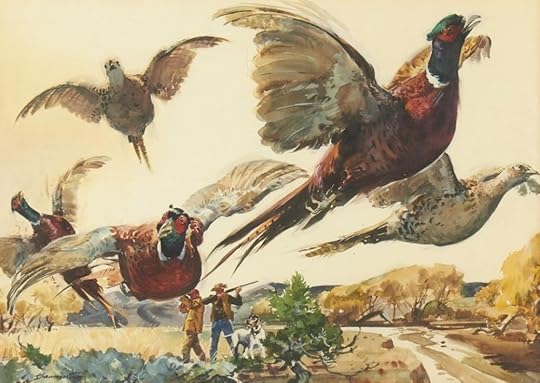 Baumgartner Artful Dodger of The Open Spaces
Baumgartner Artful Dodger of The Open Spaces We are certainly biased, but we strongly believe that curating a personal art collection is a great joy in life. And that joy is especially true and elevated in the sporting world, when we collect pieces whose lives and stories extend far beyond the artwork itself – when we collect pieces that have as much a story to tell as we do.
References:
Weir, P. (1989). Dead Poets Society. Buena Vista Pictures Distribution.
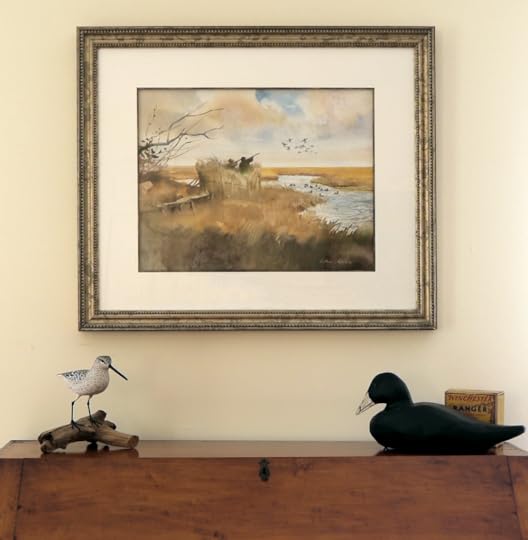 Shilstone The Duck Hunters
Shilstone The Duck HuntersAbout father & daughter team Fred & Katie Polhemus of Sportsman’s Palette: Fred has been one of America’s leading experts on Contemporary Sporting Art for over 30 years, with expertise developed at companies and organizations such as The Orvis Company, Greenwich Workshop, and International Game Fish Association. His writing on Sporting Art has appeared in many publications including Gray’s Sporting Journal, The American Fly Fisher, Covey Rise, and Cowboys & Indians Magazine, among others. He penned Arthur Shilstone: A Lifetime of Drawing & Painting, the comprehensive book on the 70+ year career of premiere Sporting Art watercolorist Arthur Shilstone. Katie graduated from Carnegie Mellon University in 2019 with a degree in Linguistics. As someone who grew up surrounded by the genre, Katie aims to kindle a passion in Sporting & Landscape Art among younger generations. She was recently published in the Winter 2022 issue of The American Fly Fisher, profiling the South American Angling Artist Sebastián Letelier. Together, they represent over 24 of the top Contemporary Sporting Artists through Sportsman’s Palette, Inc. and The Orvis Sandanona Shooting Grounds in Millbrook, NY, providing specialized guidance to private and institutional Sporting Art collectors worldwide. Fred currently resides in the northwest hills of Connecticut and can be reached at (802) 598-8301 or sportingartnews@gmail.com, and Katie currently resides in the greater Boston area and can be reached at (802) 598-0996 or polhemuskatie@gmail.com. Available work can be viewed at sportsmanspalette.com.
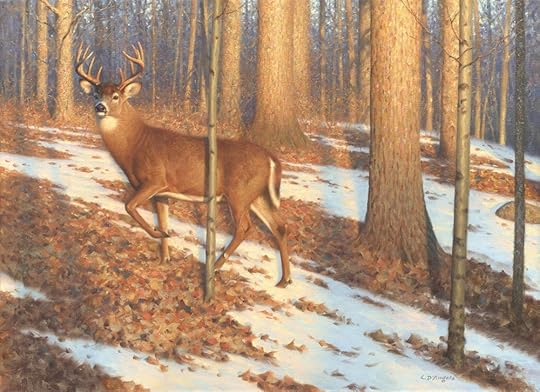 D’Angelo A King’s Crown
D’Angelo A King’s Crown



